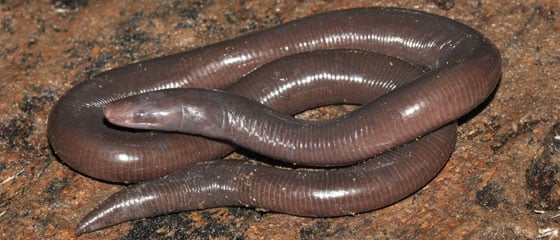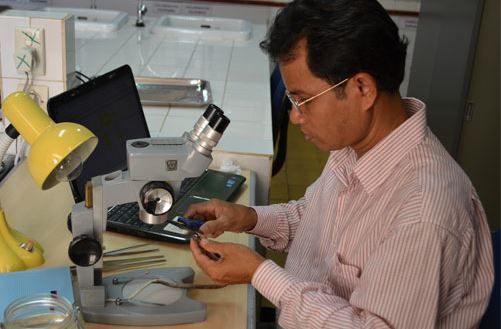Scientists have discovered a new species of legless amphibian in the Cardamom Mountains of Cambodia. Called Ichthyophis cardamomensis, the new species is a caecilian.
The caecilians are an order of amphibians that look very much like snakes or earthworms. Unlike the majority of amphibians, caecilians mostly live hidden in the ground. They are found in the tropical areas of southern Asia, Africa, Central and South America. The larger species can be up to 1.5 meters long.
Scientists at Fauna & Flora International and the Royal University of Phnom Penh, who made the discovery, said this species is only 30 cm long.
FFI herpetologist Neang Thy, who has been researching reptiles and amphibians for the past 13 years, says he is very excited that the I. cardamomensis has been officially confirmed.
The latest discovery is one of three new species of unstriped Ichthyophis caecelians. The other two were discovered in Vietnam.
A new species, the Ichthyophis cardamomensis, a caecilia, was discovered in Cambodia’s Cardamom Mountains. (Image: Fauna & Flora International)
Cambodian species samples were gathered by Neang Thy and Dr. Lee Grismer from the US La Sierra University in Riverside, California. Lead author Dr. Peter Geissler, from the State Museum of Natural History in Stuttgart, Germany, gave the final confirmation.
Why are caecilians important to conservation?
This latest discovery is only the second caecilian species to be discovered in Cambodia. The other was the striped Koa Tao Island caeciliean (I. kohtaoensis), which can also be found in Vietnam, Thailadn, Myanmar and Laos.
This Ichthyophis cardamomensis was 30cm long. (Image: FFI)
Thy said:
“These discoveries are important to demonstrate that much of Cambodia’s biodiversity remains unknown and unstudied by science, and many more areas need to be searched.”
More than eighty threatened species live in the forested Cardamom Mountain Range, including the gaur (Indian bison) and Asian elephant.
Over the past few years, scientists have become increasingly aware of the Cardamom region’s extensive amphibian and reptile diversity, including crocodiles, lizards, turtles and frogs.
“We are still learning about this area and the animals in it, since it was a region formerly held by the Khmer Rouge and the mountains were closed to researchers until the 1990s,” Thy said.
Neang Thy was instrumental in this latest discovery. (Image: FFI)
“The Cardamom region it is under threat from logging, land concessions, and other habitat destruction, and the danger of any new species, including the new caecilian, is that they may be discovered one year and go extinct the next,” he added.
Caecilians play a key role in the ecosystems of subtropical and tropical regions, including providing a food source for the red-trailed pipe snake (Cylindrophis ruffus). Caecilians eat termites, ants, earthworms and other invertebrates.
Caecilians are not an easy group to describe. They look very similar and there are very few caecilian experts around. In order to recognize a new species DNA analyses are required.
Caecilians of the genus Ichthyophis are some of the least well known amphibian taxa (groups of biological organisms) within Southeast Asia, zoologist Dr. Peter Geissler says.
Dr. Geissler said:
“Three distinct unstriped Ichthyophiid species – I. cardamomensis from western Cambodia, I.catlocensis from southern Vietnam, and I.chaloensis from central Vietnam are now described as new species, almost doubling the number of Ichthyophis species known from the Indochinese region.”
Citation: “New Ichthyophis species from Indochina (Gymnophiona, Ichthyophiidae): 1. The unstriped forms with descriptions of three new species and the redescriptions of I. acuminatus Taylor, 1960, I. youngorum Taylor, 1960 and I. laosensis Taylor, 1969,” Peter Geissler, Nikolay A. Poyarkov Jr., Lee Grismer, Truong Q. Nguyen, Hang T. An, Thy Neang, Alexander Kupfer, Thomas Ziegler, Wolfgang Böhme, Hendrik Müller. Organisms Diversity & Evolution. 10.1007/s13127-014-0190-6. Springer Berlin Heidelberg.




